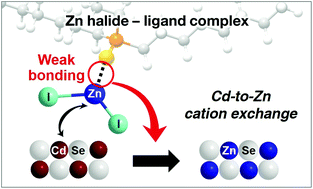Direct cation exchange of CdSe nanocrystals into ZnSe enabled by controlled binding between guest cations and organic ligands†
Abstract
Zn chalcogenides are suitable candidates for blue-emitting fluorophores in light-emitting devices. In particular, the efforts to grow ZnSe nanocrystals (NCs) with fine control over size and shape via bottom-up approaches have faced challenges because of the slow decomposition of Zn precursors. In this study, we report direct cation exchange from CdSe NCs to ZnSe. Absorption spectroscopy and density functional theory (DFT) analysis reveal that the reactivity of cation exchange depends on the degree of complexation between organic ligands and Zn halides. We controlled the binding strength of Zn complexes by changing the organic ligands and halogen species that bind with Zn. Appropriate binding strength allows for the release of Zn ions and their facile incorporation into CdSe seed NCs. Under our experimental conditions, trioctylphosphine oxide (TOPO)–ZnI2 drives the efficient cation exchange reaction whereas TOPO–ZnCl2 induces no cation exchange of CdSe NCs. In addition, functional groups vary the binding strength between Zn and ligands. Oleylamine (OLAm)–ZnI2, which has a weaker ligand–ZnI2 binding than TOPO–ZnI2, breaks down the original morphologies of host CdSe NCs due to the very fast exchange rate. On the other hand, the TOPO–ZnI2 complex induces a mild exchange rate, leading to transformation into various morphologies such as CdSe nanorods (NRs) and nanoplatelets (NPLs) into CdSe/ZnSe heterostructures inaccessible via other synthesis methods. The incorporation of Zn into various morphologies of CdSe results in tunable optical transitions in blue-UV regions. The synthesis of heterostructured NCs in an elongated morphology is possible, opening opportunities in photocatalysis, light emitting diodes, and luminescent solar concentrators.

- This article is part of the themed collection: 2019 Nanoscale HOT Article Collection


 Please wait while we load your content...
Please wait while we load your content...